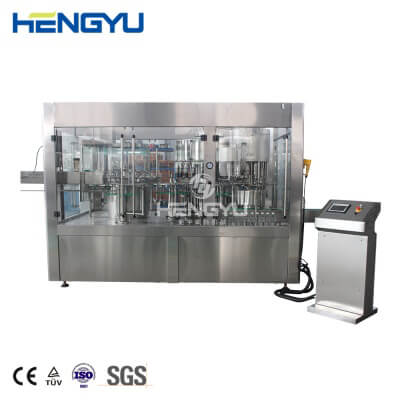© 2018 Zhangjiagang Hengyu Machinery Co.,LTD All rights reserved. Designed by iwonder.cn Site Map
Email: info@hengyu-machinery.com
Email: info@hengyu-machinery.com
Hengyu aims providing information to business owners on the best way to choose their filling machines. Here, we have provided information on the classification of the glass bottle water filling machine and we hope it will guide you in selecting the best that will suit your application and industrial needs.
Let’s get started.
Mechanized filling can not only improve labor productivity, reduce product loss, ensure packaging quality, it will also reduce mutual contamination between the production environment and the loaded materials. Generally, modern beverage industry generally adopts a mechanized filling machine.
Classification of the liquid bottling machine:
When classifying the bottling machine, there are some factors that need to be considered. For example, the different filling materials (Paste, gas containing liquids, liquids alone). If the material is water as seen in the bottle water production industries, the bottling machine can be referred to as the water bottle filling machine. Another factor to consider is the different containers (bottles, boxes, cans, bags, barrels, etc.).
However, the filling machine can be classified as follows:

1. According to the degree of automation: manual filling machine, semi-automatic filling machine, automatic filling machine, combined filling and capping machine.
2. Quantitative device: vessel filling machine, liquid level filling machine, rotor filling machine, plunger filling machine.
3. according to the structure: linear filling machine, rotary filling machine.
4. according to the number of filling heads: single head filling machine, multi-head filling machine.
5. According to the feeding cylinder structure: single chamber feeding filling machine, double chamber feeding filling machine, multiple chamber feeding filling machine.
6. Filling principle: vacuum filling machine, atmospheric pressure filling machine, back pressure filling machine, negative pressure filling machine, pressure filling machine.
7. According to the type of material liquid: for water, we have the water filling machine.
8. According to the lifting structure of the packing container, it is divided into a lifting filler machine with sliding guide, a pneumatic lifting filler machine and a pneumatic sliding combination lifting machine.
Selection of the filling machine: the rational selection of the filling machine is an important way to guarantee the quality of the product and improve the economic benefits. In general terms, should be closely related to the actual production, as far as possible to choose a good quality, high efficiency, simple structure, easy use and maintenance, small volume, light weight filling machine.
The knowledge of the filling machine should follow the following principles when choosing the filling machine.
Principle of water filling:
The principle of service for the production process. First, the properties of the filling materials will help in the selection of the appropriate filling machine for example foaming, viscosity, gas content, volatility, etc. These properties are quite important in meeting the requirements of the method adopting in the production. For example, the atmospheric pressure filling machine or cup filling machine is the best to use if loss of volatile aromatic substances in strongly scented liquor is to be avoided; for juice liquor, to reduce contact with air and ensure product quality, a vacuum juice filling machine should be used in general.
The principle of high productivity and good product quality. Productivity directly reflects the production capacity of the production line. Therefore, the higher the productivity, the better the economic benefits. To improve the quality of the products, the water filling machine must be selected with high precision and high automation. However, the sale price of the equipment has been increased correspondingly, which has increased the unit cost of the product.